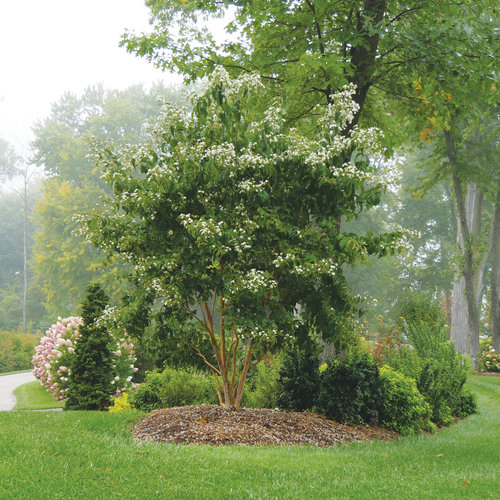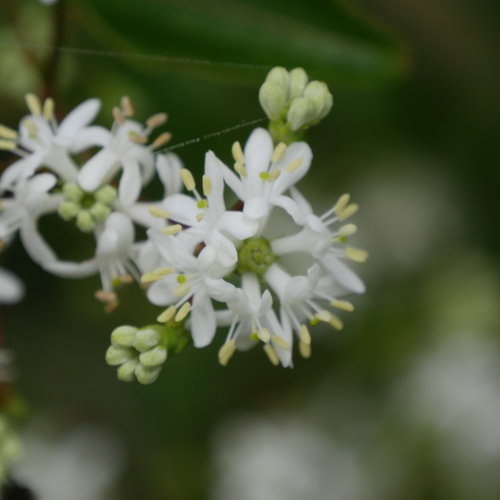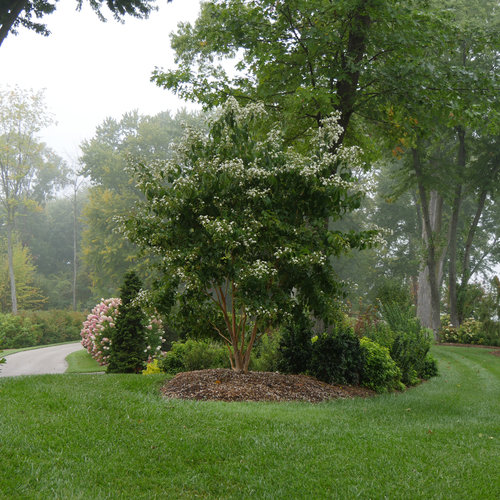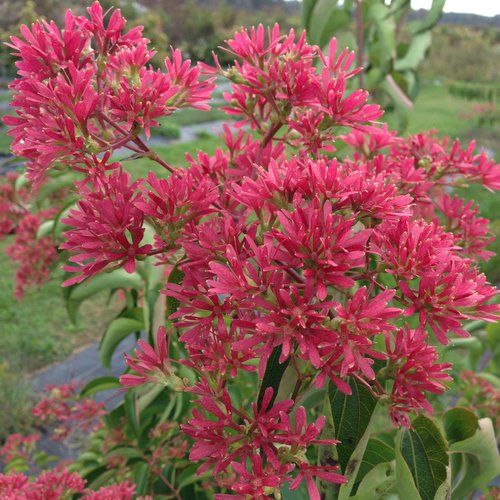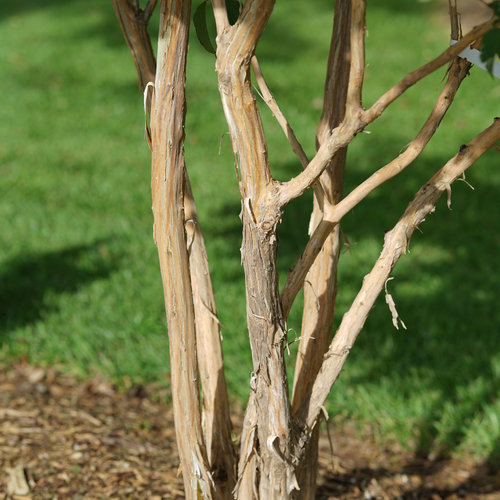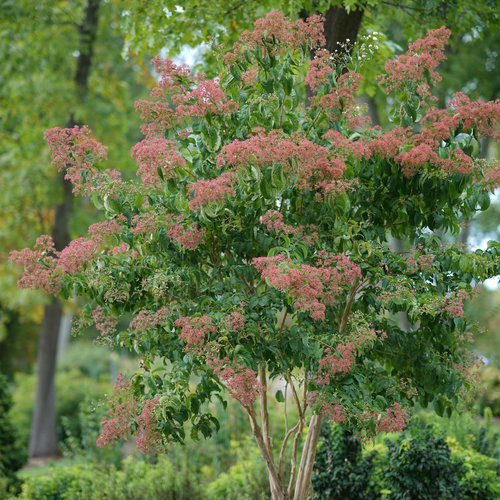I picked this plant at our local nursery for the great shape it had to train it into a multi stem tree. Two years later after shaping it as I wanted it, this winter killed all stems except one to the ground. Reset prune had to be done after two years (ugh). PA Zone 7a (6b).
Temple of Bloom® Seven-Son Flower Heptacodium miconioides
- Part Sun to Sun
- Sun
- Spring
- Summer
- Fall
- Winter
-
180 - 240 Inches72 - 120 Inches72 - 120 Inches4.6m - 6.1m1.8m - 3.0m1.8m - 3.0m
Features
Hang on to your hat - Temple of Bloom® seven-son flower is going to blow your mind!
We are thrilled to be able to bring this outstanding plant, previously known only by collectors and plant geeks, to everyone in North America. Temple of Bloom seven-son flower is a beautiful, easy to grow small tree which simply can't be matched for year-round beauty. In spring, the handsome leaves emerge, each sporting dramatically deep veins that make the plant stand out in the landscape. As the season progresses, the leaves grow larger and develop a long, twisting tip. Come August, when everything else is winding down, Temple of Bloom seven-son flower is just coming into its own, as it becomes covered in big clusters of fragrant white flowers that hummingbirds and other pollinators flock to. They last for weeks before gracefully falling to the ground to reveal vivid red, fan-like bracts, which make it look like the plant is blooming again in a completely different color. As winter comes and the leaves drop, the plant's elegant frame is revealed, along with amazing light tan peeling bark.
Temple of Bloom® seven-son flower is the perfect choice for a special spot in your landscape. Plant it where it can be seen, often, and enjoyed any time of the year. Available in better garden centers in spring 2019.
Top reasons to grow Temple of Bloom® seven-son flower:
- Contribute outstanding interest to your home but needs little care.
- Flowers in late summer and fall, when other plants are winding down.
- Peeling bark looks great year-round but is especially memorable in winter.
If you can't tell, we're more than a little excited about Temple of Bloom® seven-son flower!
Long BloomingFall InterestWinter InterestHeat TolerantAttracts:BeesButterfliesHummingbirdsCharacteristics
Plant Type:TreeShrub Type:DeciduousHeight Category:TallGarden Height:180 - 240 Inches 4.6m - 6.1mSpacing:72 - 120 Inches 1.8m - 3.0mSpread:72 - 120 Inches 1.8m - 3.0mFlower Colors:RedFlower Colors:WhiteFoliage Colors:GreenFoliage Shade:Deep greenHabit:UprightContainer Role:ThrillerPlant Needs
Light Requirement:Part Sun to SunLight Requirement:SunThe optimum amount of sun or shade each plant needs to thrive: Full Sun (6+ hours), Part Sun (4-6 hours), Full Shade (up to 4 hours).
Maintenance Category:EasyBlooms On:New WoodBloom Time:Summer through FallHardiness Zones:5a, 5b, 6a, 6b, 7a, 7b, 8a, 8b, 9a, 9bWater Category:AverageUses:Border PlantUses:LandscapeUses:Specimen or Focal PointUses Notes:Temple of Bloom™ seven-son flower is at its best as a specimen, thanks to its elegant habit. However, it is amenable to pruning, which offers it some versatility in the landscape. It is highly attractive to butterflies and hummingbirds, so consider planting it someplace where you can enjoy all the activity it invites.
Though its exact form will depend on how the grower has trained it, it is typically a small, multi-stemmed tree that reaches around 10' tall at maturity.
Maintenance Notes:Believe it or not, this beautiful and unusual plant requires essentially no care. It isn't finicky about soils, though it does appreciate regular moisture and good drainage. It will not require any special pruning, though you may prune or train it to your liking if you prefer. If you do prune it, do that in late winter or early spring, as the flower buds begin to set shortly after the plant leafs out.
Temple of Bloom™ seven-son flower does not need special fertilizing, but if you wish to encourage more rapid growth, you may apply a granular fertilizer formulated for woody plants (like a rose fertilizer) in early spring.
Fun Facts:Temple of Bloom™ seven-son flower differs from other Heptacodium on the market in that the bracts (actually sepals) develop a much deeper red color. Plus, it blooms earlier, so that even in colder areas of its hardiness range, you'll still get a chance to see that color develop. It's also a bit smaller in its overall height.
The common name, "seven-son flower" derives from the way that the flowers are arranged on the stems.
Temple of Bloom® Heptacodium miconioides 'SMNHMRF' USPP 30,763 -
5164331213Browse reviews from people who have grown this plant.
-
CRalat, Pennsylvania, United States, 32 weeks ago
-
I bought this plant 3!years ago at our local garden centre. It was less than 12 inches tall and has now grown to over 5 feet and is full and lush. I live in Canada and our winters are wet and cold. I do nothing for this plant. I do t water fertilize or prune. It’s thriving in heavy clay soil. I’m so happy with this purchase.
Farah, Ontario, Canada, 1 year ago -
Hello - This is my second zone 9 CA summer trying to find a permanent spot for my Temple of Bloom tree. I have burned it twice and discovered that it does not appreciate being pushed into direct sun. The summer of 2022 it was in an east facing spot where it received sun from 7 am-1 pm and it burned, I moved it to where it barely stays in the shade and it recovered. This summer of 2023 I tried a spot where it received sun from 9:30 am-1:30 pm and the leaves burned again. I placed it back in the same barely shaded spot. I don't have any locations with early sun only. Next summer my new shade trees might be big enough to provide dappled shade. Happy gardening!
Heather M., California, United States, 2 years ago -
This is our second summer with these lovely trees. We initially purchased in fall 2021, and we are in zone 5b. The trio survived an extremely cold winter. Last winter the weather was not as severe, and this spring/summer the three have taken off. As of this writing, July 15th, the flowers are beginning to form. We can't wait to see the show!
Julie B, Illinois, United States, 2 years ago -
I’ve grown three of these in different regions in Wisconsin. My first Heptacodium was purchased from a popular mail order nursery located in Ohio. It was the species tree and not a cultivar. I believe they only sell the cultivars in their catalog now and not the species. I lived in Wauwatosa at the time, zone 5. The plant arrived via mail order literally the size of a pencil. I planted it, and I’ve never seen something so small grow into such a large tree in such a short amount of time. We had very rich compacted soil in Wauwatosa. If you want to attract pollinators to your yard, I guarantee this will be covered with bees. We had bumble bees galore buzzing all around this tree. It’s a beautiful tree, easy to prune. I wanted to grow mine as a multi-stemmed specimen. I still look at google earth snapshots of my old property to see how this tree has matured and I can see from the google street views this tree is flourishing. It is STUNNING. I now live further north in Green Lake County (zone 5a) and I have planted another of the species AND a Temple of Bloom cultivar. The soil here is very sandy and acidic. This will be the second growing season for me here so I’m hoping they take off in terms of growth rate like it did at my last home. The blooms and the bark and the multi stemmed form is just beautiful, as well as the foliage. Rabbits never bothered mine though they devour my serviceberry shrubs. I have to fence around my serviceberry but not my heptacodium. If I moved again, the heptacodium would be the first thing I would plant in my yard. What a glorious tree.
WIKim, Wisconsin, United States, 3 years ago -
This is the most amazing bush/small tree you will ever own. The peeling bark and white trunk are stunning year round and once it obtains full size the blooms will knock your eyes out. Perfect time when pollinators are looking for nectar and pollen. I have had monarchs, swallowtails, bees and hummingbirds on this shrub all at the same time. You can definitely prune it back to the shape you prefer, best time shortly after blooming. Otherwise you are cutting off next years blossoms. This is probably one of my favorites ever!!
Elise S. Gerke, Wisconsin, United States, 4 years ago -
I ordered directly from Proven Winners. The plant was only available in the small size, but I really wanted to give it a try so I ordered it and planted it In late fall. I was worried about planting such a little one with Wisconsin’s winter coming soon. I fenced it off because rabbits would have killed it. I also put a good amount of shredded fall leaves around the base in the hope of keeping it a little warmer. It is very tiny but it looks healthy and the leaves are very pretty even on such a little one. I’m very optimistic and excited to give this plant a try. We’re making a garden bed around her to give her a showy setting. There will also be 2 aphrodites in that same bed.
Kimberly, Wisconsin, United States, 5 years ago -
I received this plant in the spring. It was too small to plant so I grew it in containers all summer. Last week I planted it in the ground in Pittsburgh, in zone 5b or maybe 6a. It now has 3 or 4 healthy long branches which extend outward so it would be a bush. I want it to be a tree and am unsure how to prune it to encourage upward growth, It is very healthy and I am sure it will grow well, but it would be helpful to have expert advice about how to go about pruning these sideways extending branches.
Amy Van Buskirk, Pennsylvania, United States, 6 years ago -
I ordered this plant in spring of 2019 and planted it in my new front flowerbed. It has thrived and grown wonderfully. I am shocked at how quickly it has grown and now I am enjoying the new blooms already on the first year. Very impressed. The only thing I'm unsure about is if I need to prune it this winter. It is fairly bushy rather then upright. I am hoping I can trim and train it to be a small tree.
Brooke, Oregon, United States, 6 years ago -
I bought this plant this year in the quart size and it showed up green and cut back. I planted it in hard clay soil and added some starter fertilizer and it is already branching! I don’t expect it to get big anytime soon, but anything that can survive in Kentucky soil sure is a winner!
Dalton Curtis, Kentucky, United States, 6 years ago
-



